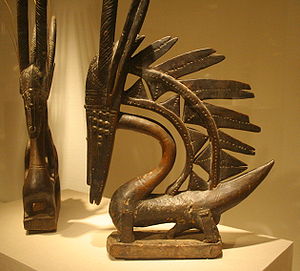Mask 1- This mask is called a Pende mask. It is a ‘Panya Ngombe’ which is a combination of a human and buffalo features. This comes from the Kasai Pende tribe. These masks are usually decorated with triangular patterns and painted with dark and light paints to created a checkerboard effect. This mask would be hung above the door to the chiefs living quarters. The Pende tribe carves several different types of masks that they use to communicate with spirits during rituals.
Mask 2- This type of mask is called a Baule mask, also known as the Goi mask. It is used in tribal dances during harvest festivals, in processions to honor distinguished visitors and at the funerals of important people. Its circular face represents the sun and the horns represent the power of a buffalo. There are two holes cut out for eyes so that the wearer can see and there is typically a rectangle mouth carved into it.
Mask 3- Dan masks typically have high foreheads, a pointed chin, and a pouting mouth. They may also have scarification that splits the forehead and nose. These masks are carved in wood and stained with a brown dye. Dan masks can be used for protection and as a channel to communicate with the spirit world. When a dancer wears a Dan mask he becomes the spirit of that mask. A masked dancer will speak in the language of the spirits and his words are interpreted by a wise man. There are many different Dan masks, each one has a distinct use during rituals or festivals. Some masks play an important part in tribal rites while others are just for entertainment.
Statue 1- This statue is a very rare Black & Red Man puppet made by the Bamana tribal people of Mali, Africa. This puppet was used in presentations of tribal history and rules of behavior. This statue has moving arms and legs and is called a rod puppet because of the rod the puppeteer holds to make it dance.
Statue 2- The Chiwara statue is a ritual object that represents an antelope. It is used by the Bambara ethnic group in Mali. The Chiwara initiation society uses Chiwara masks as well as dances and rituals associated mainly with agriculture to teach young men of Bambara about social values and agricultural techniques.




